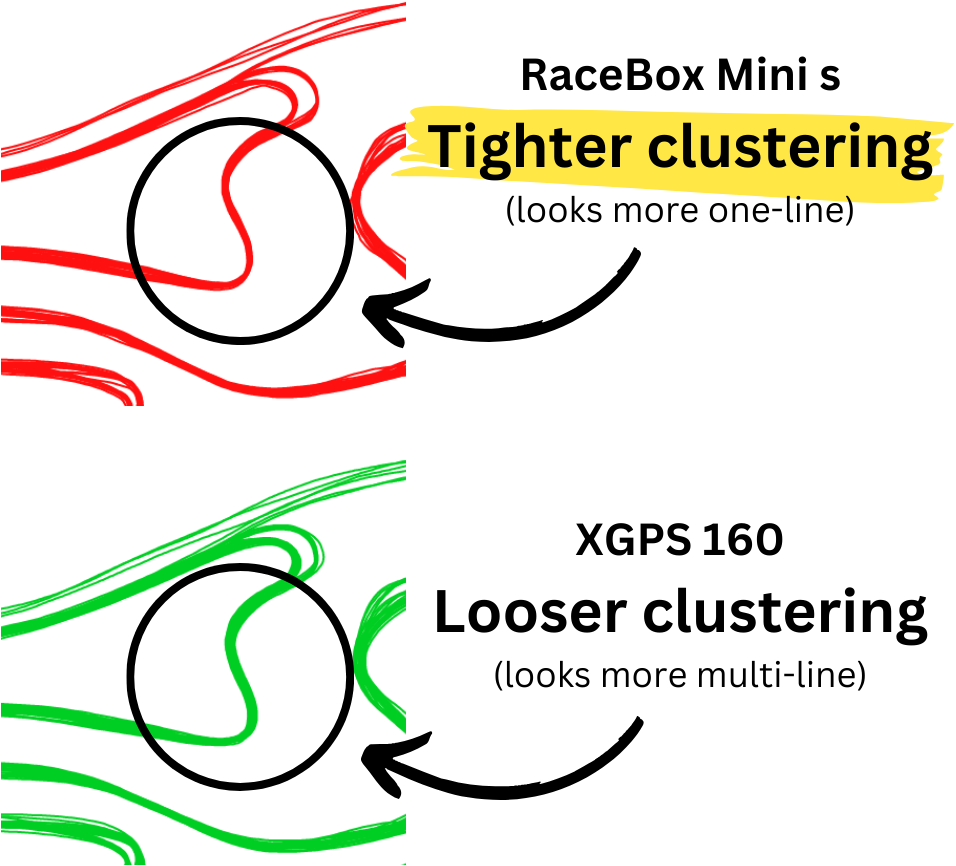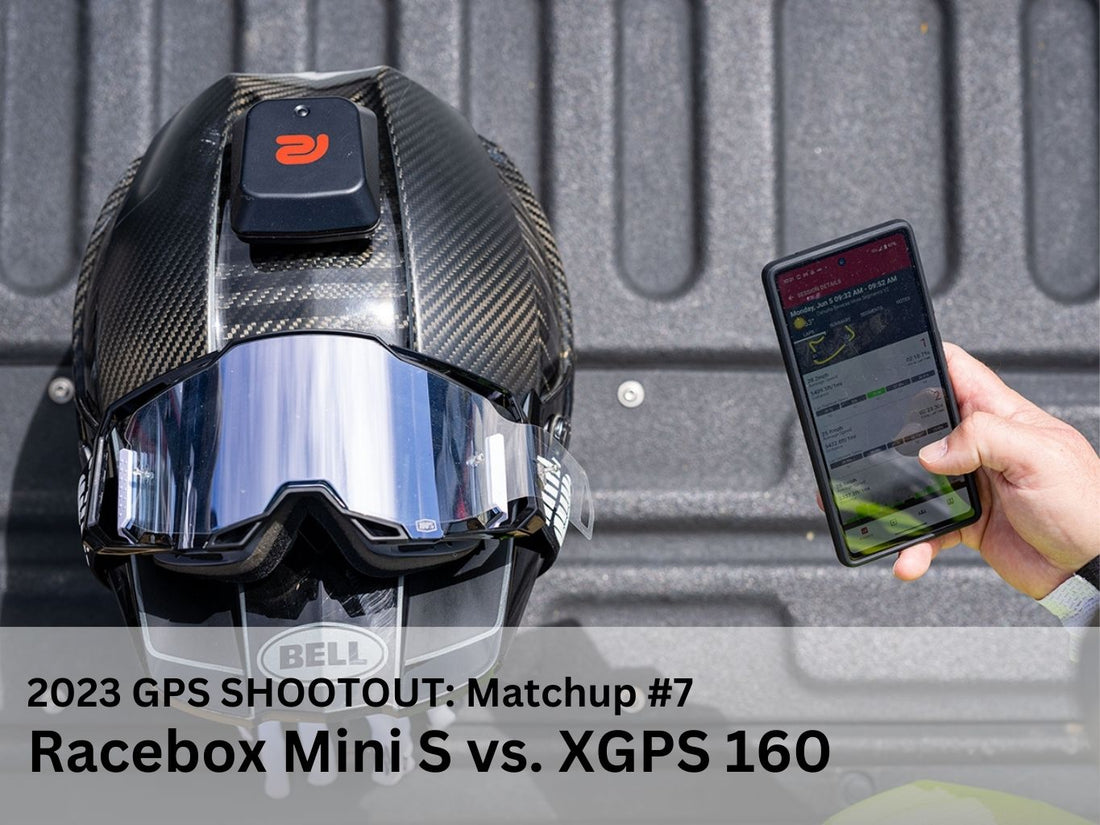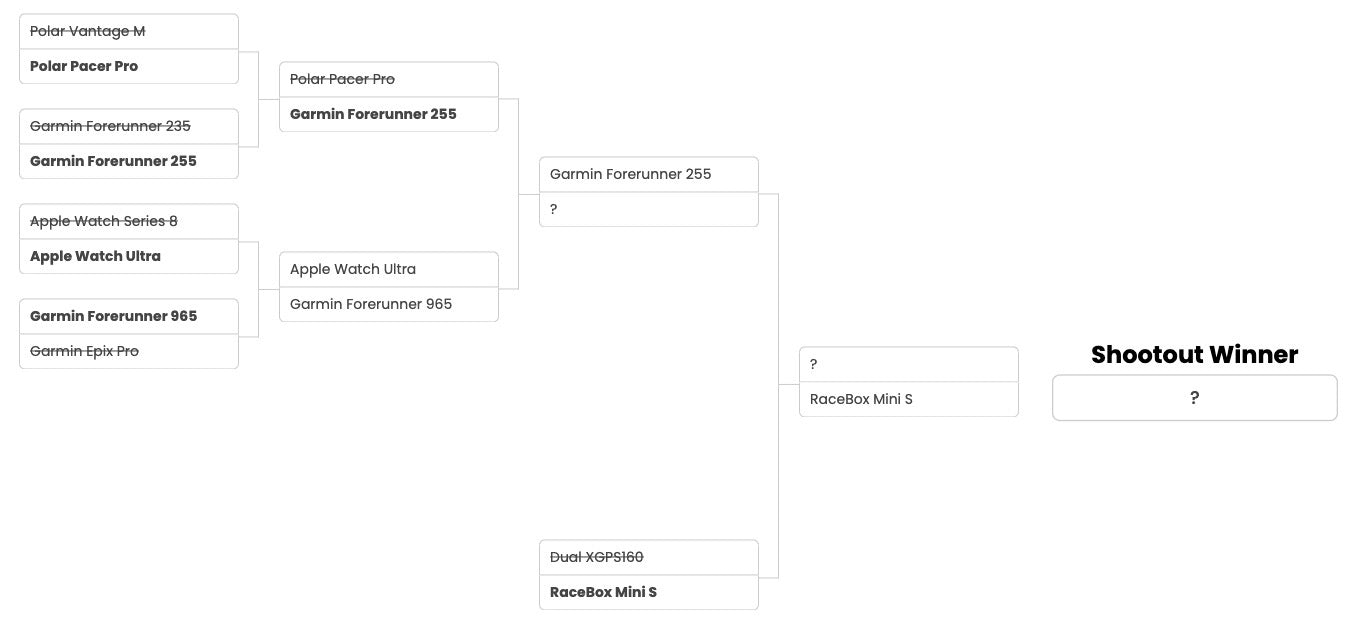This post is part of the 2023 LITPro GPS Device Shootout series. To learn more about the details of this shootout, including format, devices we tested, and how we determine a winner, go here: 2023 GPS Shootout Intro.
Matchup #7 - RaceBox Mini S vs. Dual XGPS160

Testing was conducted at Fox Raceway in Pala, CA. This is a Southern California track in a great location for GPS device testing. There isn’t a lot of tree cover, or mountainous landscape to obscure satellites on the horizon.
FIRST NOTE ON THIS MATCHUP (Mounting Location):
We faced a dilemma with the XGPS160 and the Mini S: there wasn’t enough room on the helmet for both. Ideally, GPS antennas are best placed on the helmet’s top, offering an unobstructed sky view in all directions. This location is premium because satellites near the horizon are crucial for accurate GPS readings, and any other spot may block their line of sight due to the rider’s body or the bike itself.
With this in mind, we had to choose which device to favor. The Mini S was mounted on the rear fender, and the XGPS160 got the prime position on top of the helmet. By giving the XGPS160 this mounting edge, it was poised to perform better. Conversely, the Mini S was at a disadvantage due to its mounting location. We hypothesized that if the Mini S still outperformed despite the handicap, it would confirm its superiority. And that’s precisely what we put to the test.
SECOND NOTE ON THIS MATCHUP (No Reference Device):
Since both the XGPS160 and the Mini S log high-rate position data (10Hz for the XGPS160 and 25Hz for the RaceBox Mini S) and can simultaneously access multiple satellite constellations, they could potentially serve as references for each other. The benefit of multiple constellations is the increased number of satellites visible at any given time, which enhances the chances of connecting with those crucial horizon satellites for precise positioning.
However, this setup means we’re missing our usual ground truth dataset, which makes our analysis for this shootout slightly different than the others. For context, in all our previous shootouts, the Mini S has been our go-to reference device.
RaceBox Mini S vs. Dual XGPS160
| 9:53AM - Vet track (Mini S on rear fender, XGPS160 on helmet) | |||
|---|---|---|---|
| Lap | RaceBox Mini S | XGPS160 | Delta |
| 1 | 01:53.15s | 01:53.20s | 0.05 |
| 2 | 01:50.55s | 01:50.55s | 0 |
| 3 | 01:53.40s | 01:53.45s | 0.05 |
| 4 | 01:51.30s | 01:51.25s | 0.05 |
| 5 | 01:48.80s | 01:48.80s | 0 |
| 6 | 01:48.05s | 01:48.05s | 0 |
| 7 | 01:51.85s | 01:51.90s | 0.05 |
| 8 | 01:47.20s | 01:47.20s | 0 |
| 9 | 01:51.90s | 01:51.85s | 0.05 |
| 10 | 01:48.60s | 01:48.65s | 0.05 |
| 11 | 01:47.05s | 01:47.10s | 0.05 |
| 12 | 01:46.90s | 01:46.95s | 0.05 |
| 13 | 01:50.40s | 01:50.35s | 0.05 |
| 14 | 01:48.25s | 01:48.25s | 0 |
| 15 | 01:51.45s | 01:51.65s | 0.2 |
| 16 | 01:51.40s | 01:51.45s | 0.05 |
| 17 | 01:44.25s | 01:44.35s | 0.1 |
| 18 | 01:44.35s | 01:44.40s | 0.05 |
| 19 | 01:47.15s | 01:47.10s | 0.05 |
| 20 | 01:48.70s | 01:48.85s | 0.1 |
| 21 | 01:46.65s | 01:46.75s | 0.1 |
| 22 | 01:48.75s | 01:48.85s | 0.1 |
| Largest Delta | 00:00.20 | ||
 |
 |
 |
| RaceBox Mini S (on rear fender) | XGPS160 (on helmet) | RaceBox Mini S (red) vs. XGPS160 (green) |
Head to Head Results:
#1 Timing accuracy: RaceBox Mini S vs. Dual XGPS160 (Objective Analysis):
As highlighted previously, we find ourselves without a definitive reference device for this test—both units could serve as a benchmark. Consequently, our usual objective analysis is somewhat constrained, leaving us to share our observations rather than conclusively crowning a winner. So, let’s look at the facts: the greatest discrepancy recorded between the devices was a mere 0.2 seconds, and this was a solitary instance across 22 laps. On average, the time difference was about 0.05 seconds, which falls comfortably within the margin of error for 20Hz systems. Accounting for the occasional data point deviation, the performance of the two devices was strikingly similar.
#2 Top-down visual ranking RaceBox Mini S vs. Dual XGPS160 (Subjective Analysis):
In the absence of a standard reference device, we had to innovate our approach to determine the superior GPS unit. We decided to increase the number of laps, more than in any previous tests, and scrutinize the clustering on track sections where the rider consistently followed a single line. Given the presence of a well-worn rut that the rider used in a couple sections on the track, the more precise GPS should demonstrate an overlay of 22 laps of data so tight that it appears as a single track. Essentially, the ideal GPS unit would present this consistency with minimal deviation, almost making it indistinguishable that it represents multiple laps. In our quest for accuracy, we sought the GPS device that would come closest to this level of perfection.
First test case is this S-curve/Chicane in the northeastern side of the track. Here there was a single rut the rider took all 22 laps. Notice the win goes to the Mini S here because you can see it is closer to showing a single-line through this section.

Additionally, on the west side of the track, there's a corner with a distinct inside and outside line. On the XGPS160 those two lines merged together where it became difficult to distinguish inside versus outside. On the Mini S, however, those lines are really clear.

Wrap Up Summary:
Ultimately if you are using a precision GPS device such as the Mini S, or the XGPS160 you should expect to see with confidence which line you took in a corner, for example, and if it was faster or not. The verdict of our comprehensive analysis is that the Mini S emerges as the winner in this matchup. It’s noteworthy that the Mini S achieved this despite being at a presumed disadvantage due to its mounting position, further solidifying its superior performance.
For typical motocross tracks, the Mini S has proven to deliver precise GPS accuracy regardless of whether it’s mounted on the front fender, rear fender, or helmet. This pinpoint precision ensures that riders can trust the LITPro's analytics for line choice, braking points, and acceleration timing, among other metrics.
During our rigorous tests, the Mini S displayed an exceptional ability to replicate nearly identical lap lines, even when navigating the same rut 22 times—a testament to its consistency and reliability. Furthermore, in situations where only distinct inside or outside lines were available, the Mini S presented clear and separate line clusters. This level of accuracy is what riders expect from a high-end GPS device, and the Mini S consistently delivered, outperforming the XGPS160.
While both the XGPS160 and the Mini S offer satisfactory accuracy—and we endorse both—it’s the consistent edge of the RaceBox Mini S that leads us to crown it as the definitive winner of this matchup.


